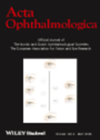
Journal Reviews
Bromfenac versus betamethasone in diabetic macular oedema
This is a randomised, prospective, single-centre trial in patients diagnosed with diabetic macular oedema (DMO) with central subfield thickness (CST) of 250-500µm, who refused anti-VEGF treatment. Nineteen eyes of 19 patients were randomised to bromfenac (BF) or betamethasone (BM) drops,...
The effects of ab-interno XEN gel implantation on postural IOP elevations
The study involved 18 patients with XEN gel implants, 30 patients who had trabeculectomy, and 30 medically managed glaucoma patients. All patients in XEN gel implant and trabeculectomy groups had at least 11 months of follow-up following successful surgery resulting...
Efficacy and safety of novel PF brimonidine / timolol fixed-combination ophthalmic solution for OAG
This study is a multicentre, randomised, open-label, parallel-group clinical trial to evaluate the efficacy and safety of a newly developed preservative-free (PF) brimonidine / timolol fixed-combination (BTFC) ophthalmic solutions as compared with preservative-containing (PC) BTFC ophthalmic solution in adult patients...
Visual and refractive outcomes and complications in FLACS versus CPS cataract surgery
This is a randomised, controlled study of 110 paired eyes from 55 patients that were randomised into either femtosecond laser-assisted cataract surgery (FLACS) or conventional phacoemulsification cataract surgery (CPS) groups. Visual, refractive outcomes, intraocular pressure (IOP) and complications were compared...
Relationship between intraocular pressure and optic nerve damage in optic nerve drusen
The authors present a retrospective study exploring the relationship between intraocular pressure (IOP) and optic nerve damage in patients with optic nerve drusen. The aim was to evaluate if patients with normal ocular pressure at the time of optic nerve...
Lens surgery in patients with lens subluxation misdiagnosed as primary angle-closure glaucoma
Lens subluxation can be caused by many conditions including Marfan syndrome and other hereditary conditions, and blunt trauma. Lens displacement can cause pupillary block and angle closure. This is commonly misdiagnosed as primary angle closure glaucoma (PACG), which can lead...
Glaucoma and capillary perfusion
Elevated IOP is important but not the sole factor responsible for retinal ganglion cell (RGC) death and optic nerve damage in glaucoma. There is increasing evidence that visual loss correlates with macular inner retinal thinning. A total of 148 eyes...
Under pressure: intraocular pressure and bariatric surgery
Obesity in the general patient population is increasing. The National Institute for Health and Care Excellence recommends bariatric surgery with body-mass index (BMI) of over 40, or between 35-40 and other significant disease that could be improved with weight loss....
Mono vs. multi-therapy in IOP control
This randomised control trial studied newly diagnosed glaucoma patients given mono‐ or multi‐therapy regarding differences in initial intraocular pressure (IOP) reduction, target IOP levels reached and influence of untreated baseline IOP on IOP reduction. Patients newly diagnosed with manifest primary...
Effect of refractive corneal surgery on IOP and glaucoma progression
Accuracy of intraocular pressure (IOP) measurement depends on the biomechanical properties of the cornea, including its thickness central corneal thickness (CCT) and keratometry (K). Fifty-six eyes of 56 patients with primary open angle glaucoma (POAG) who had a history of...
Cataract surgery and long-term risk of glaucoma in PEX
The objective of this study was to compare the development of glaucoma and IOP over an extended time period following cataract surgery in eyes with and without pseudoexfoliation syndrome (PEX), and trying to determine the impact of cataract surgery on...
Aflibercept for the treatment of neovascular glaucoma
The aim of this study was to investigate initial results regarding the treatment of neovascular glaucoma (NVG) with intravitreal aflibercept. NVG is classified into stages 0-3. In stages 1 and 2, abnormal vessel proliferation is seen with or without elevated...












